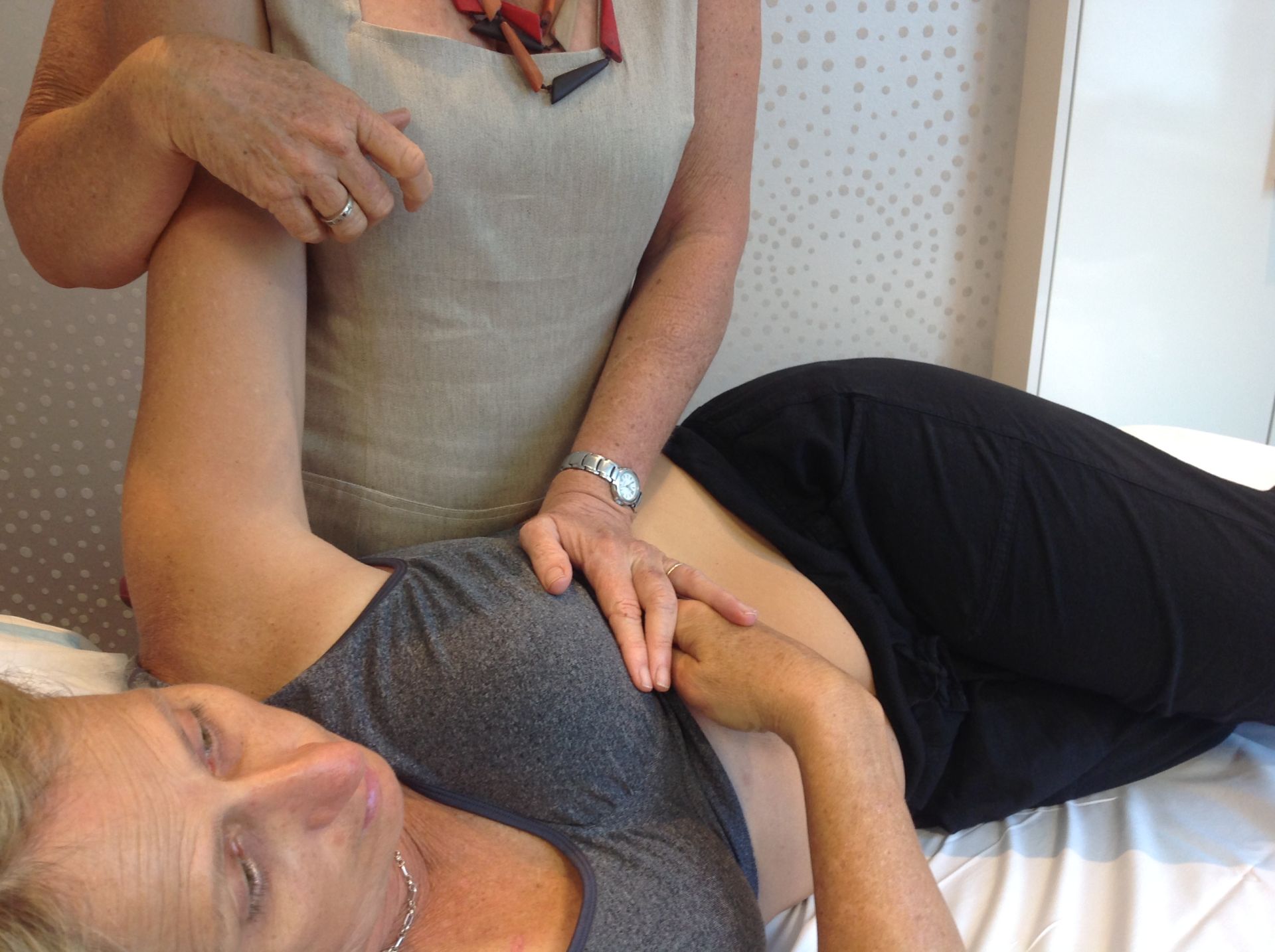Join today
How to detect
upper-body impairments following breast cancer
Planning rehab interventions for breast cancer survivors requires a systematic impairment detection approach. Learn how to detect the severity and locations of soft tissue stiffness using specific arm positioning (Reach-out-the Back test), manual palpation and targeted observation.
Denise Stewart has converted her extensive clinical oncology rehab experience to comprehensive step-by-step training for health professionals new to breast cancer rehab.
This course offers a new way of evaluating and communicating an individual's soft tissue impairments. The findings from this assessment approach can immediately guide the services of: patient referral, planning and evaluation of rehab treatments, exercise interventions and return to work needs.
This training will suit:
Manual Therapists: Physical Therapists, Occupational Therapist, Oncology Massage Therapists
Referring health professionals: Breast care nurses/ navigators, surgeons, Doctors. Lymphedema Therapists
Oncology Exercise Trainers: Exercise Physiologist, Personal Trainers
Denise Stewart has converted her extensive clinical oncology rehab experience to comprehensive step-by-step training for health professionals new to breast cancer rehab.
This course offers a new way of evaluating and communicating an individual's soft tissue impairments. The findings from this assessment approach can immediately guide the services of: patient referral, planning and evaluation of rehab treatments, exercise interventions and return to work needs.
This training will suit:
Manual Therapists: Physical Therapists, Occupational Therapist, Oncology Massage Therapists
Referring health professionals: Breast care nurses/ navigators, surgeons, Doctors. Lymphedema Therapists
Oncology Exercise Trainers: Exercise Physiologist, Personal Trainers
Write your awesome label here.
A testing method to detect the severity of impairments
-
Author: Denise Stewart
-
Level: Advanced
-
Study time: 5-10 hours
Write your awesome label here.
Course overview
Step-by-step instructions for testers:
- Arm positions
- Palpation locations
- How to palpate
- What to look for
- Measures for multiplane arm range
- Reduce neuromuscular bracing
- Measures of scar & adhesion stiffness
Testing to guide health and exercise professionals in personalized treatment and exercise planning.
-
Video time: 1hr 40 mins
-
Exams: Knowledge and skills testing
-
eBook: 1.5- 2 hours
-
Skill practice: 2-7 hours
What's included?
Discover the art and science of soft tissue
impairment testing specific to breast cancer
Our training is designed to provide skills for clinicians and exercise trainers.
Follow comprehensive steps for using Reach-out-the-Back Test with a choice of palpation or observation methods for the upper-body soft tissue system.
This testing procedure has been developed and used by Denise Stewart in her private breast cancer rehab clinic. It's low cost and quick to administer and based on the evidence of pectoral strain capacity, and fascia and skin elasticity.
Follow comprehensive steps for using Reach-out-the-Back Test with a choice of palpation or observation methods for the upper-body soft tissue system.
This testing procedure has been developed and used by Denise Stewart in her private breast cancer rehab clinic. It's low cost and quick to administer and based on the evidence of pectoral strain capacity, and fascia and skin elasticity.
Upper-body impairments are known to be problematic for breast cancer survivors across the world.
Strategies shared and knowledge learned allows students to immediately start offering their services around the globe.
Strategies shared and knowledge learned allows students to immediately start offering their services around the globe.
Working to restore loss in arm movement is very satisfying work for a health and exercise professionals.
This assessment procedure adds to the professional experience because immediate benefits of individual treatment techniques or single sessions can be measured for each individual.
Standard range of movement testing and exercises have failed to identify the nature of impairments experienced by breast cancer survivors. This comprehensive assessment strategy will lead to new rehab interventions and research.
This assessment procedure adds to the professional experience because immediate benefits of individual treatment techniques or single sessions can be measured for each individual.
Standard range of movement testing and exercises have failed to identify the nature of impairments experienced by breast cancer survivors. This comprehensive assessment strategy will lead to new rehab interventions and research.
Personalized breast cancer rehab
Upper-body care through targeted assessment
As a licenced Occupational Therapist, I understand the importance of ideal arm movements and stabilizing patterns for successfully engaging in work and home life tasks.
A number of soft tissues at the chest can be damaged or altered from both breast cancer surgery and radiotherapy. Because of the variations in cancer treatments and reactions, each individual will present with a unique range of impairments.
Stiffness, adhesions and fibrosis must be carefully evaluated in order to guide people in safe and effective stretch/ exercises, activities and work tasks.
Arm to Ear test and ROTB testing will guide the tester to the severity of these impairments and how they contribute to movement restrictions.
Providing rehab treatments specific to the individual's impairments can further help to regain best movement patterns and reduce barriers to lymphatic flow.
A number of soft tissues at the chest can be damaged or altered from both breast cancer surgery and radiotherapy. Because of the variations in cancer treatments and reactions, each individual will present with a unique range of impairments.
Stiffness, adhesions and fibrosis must be carefully evaluated in order to guide people in safe and effective stretch/ exercises, activities and work tasks.
Arm to Ear test and ROTB testing will guide the tester to the severity of these impairments and how they contribute to movement restrictions.
Providing rehab treatments specific to the individual's impairments can further help to regain best movement patterns and reduce barriers to lymphatic flow.

“Teaching these skills to other health professionals means more breast cancer survivors will receive targeted rehab and exercises ”
Denise Stewart
Occupational Therapist

THE Lesson series will allow you to answer this Question
Which ROTB test position will easily demonstrate if there is soft tissue scarring and adhesions at the drain site on the lower lateral border of pec major?
A: ROTB positions 2/10 and 1/11
Why does this matter?
Therapists can apply treatment interventions to directly target
the nature and severity of the impairment.
Why does this matter?
Therapists can apply treatment interventions to directly target
the nature and severity of the impairment.
Limitations of this training program
1. Arm to Ear test and ROTB test with manual palpation are new clinical tests that have not undergone research to investigate reliability or validity.
This limitation is managed by providing learners with extensive evidence
to support the testing methods.
Learners must review the evidence provided to develop professional confidence
to integrate these tests into practice.
Additionally, palpation, observation, or client palpation offers
a way of confirming test findings.
2. Treatment and exercise options are not presented in this training program.
Arm to Ear test and ROTB test is a core skill for health professionals and trainers
to gather more data about the individual breast cancer client.
Training for health professionals in treatment techniques to manage impairments
is presented in other training programs by Denise Stewart.
ABOUT THE COURSE TRAINER
Denise Stewart
Denise, an Australian Occupational Therapist, has developed targeted assessment and treatments for breast cancer survivors over the last 20 years. Having quick, safe and reliable testing methods were needed to evaluate the effectiveness of new manual therapy treatments for breast cancer survivors.
ROTB test was first presented at the Australasian Lymphology Congress in 2014 as a way to detect post breast cancer axillary cording.
The Breast Cancer Rehabilitation &Wellness Summit was founded in 2016 by Denise to improve networking, multi-disciplinary education and recovery awareness for both health providers and breast cancer survivors.
In 2020-2022, with the pandemic, Denise collaborated with other leading health professionals to develop off body training methods for manual therapy skills in oncology care. Setting hand compression levels for impairment assessment and treatment will aid in establishing more objective descriptions of hands-on protocols in breast cancer rehab and for future research purposes.
ROTB test was first presented at the Australasian Lymphology Congress in 2014 as a way to detect post breast cancer axillary cording.
The Breast Cancer Rehabilitation &Wellness Summit was founded in 2016 by Denise to improve networking, multi-disciplinary education and recovery awareness for both health providers and breast cancer survivors.
In 2020-2022, with the pandemic, Denise collaborated with other leading health professionals to develop off body training methods for manual therapy skills in oncology care. Setting hand compression levels for impairment assessment and treatment will aid in establishing more objective descriptions of hands-on protocols in breast cancer rehab and for future research purposes.
Write your awesome label here.
Write your awesome label here.
Never miss our news
Subscribe to our newsletter!
Thank you!


